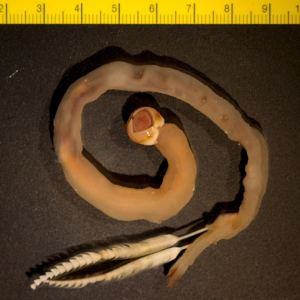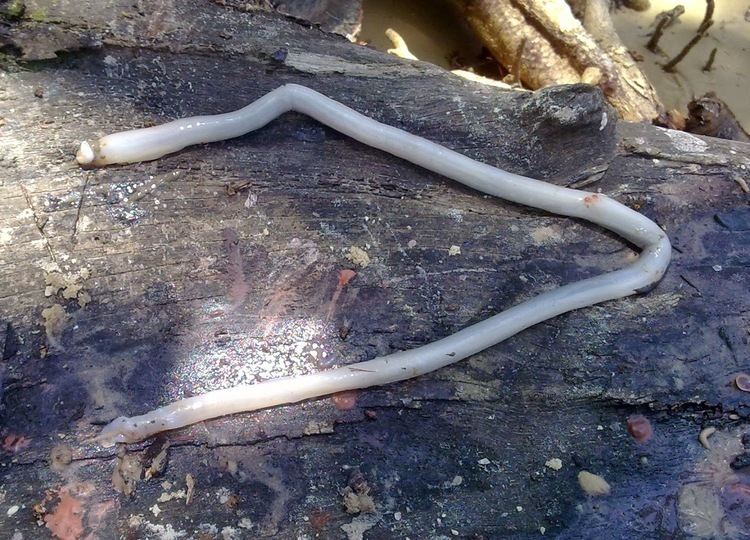Scientific name Teredinidae Higher classification Myoida Order Myoida | ||
Lower classifications | ||
Talk bu live shipworms shipwrecks and global worming
The shipworms are marine bivalve molluscs in the family Teredinidae: a group of saltwater clams with long, soft, naked bodies. They are notorious for boring into (and commonly eventually destroying) wood that is immersed in sea water, including such structures as wooden piers, docks and ships; they drill passages by means of a pair of very small shells borne at one end, with which they rasp their way through. Sometimes called "termites of the sea", they also are known as "Teredo worms" or simply Teredo, from the Greek language "τερηδων", via Latin. Eventually biologists adopted the common name Teredo as the name for the best-known genus.
Contents
- Talk bu live shipworms shipwrecks and global worming
- Description
- Biology
- Taxonomy
- Genera
- Engineering concerns
- Engineering inspiration
- Literature
- Culinary delicacy
- References
Description

Removed from its burrow, the fully grown teredo ranges from several centimetres to about a metre in length, depending on the species. The body is cylindrical, slender, naked and superficially vermiform, meaning "worm-shaped". In spite of their slender, worm-like forms shipworms nonetheless possess the characteristic morphology of bivalves. The ctinidia lie mainly within the branchial siphon, through which the animal pumps the water that passes over the gills.

The two siphons are very long and protrude from the posterior end of the animal. Where they leave the end of the main part of the body the siphons pass between a pair of calcareous plates called pallets. If the animal is alarmed, it withdraws the siphons and the pallets protectively block the opening of the tunnel.

The pallets are not to be confused with the two valves of the main shell, which are at the anterior end of the animal. Because they are the organs that the animal applies to boring its tunnel, they generally are located at the tunnel's end. They are borne on the slightly thickened, muscular anterior end of the cylindrical body and they are roughly triangular in shape and markedly concave on their interior surfaces. The outer surfaces are convex and in most species are deeply sculpted into sharp grinding surfaces with which the animals bore their way through the wood or similar medium in which they live and feed. The valves of shipworms are separated and the aperture of the mantle lies between them. The small "foot" (corresponding to the foot of a clam) can protrude through the aperture.

The shipworm lives in waters with oceanic salinity. Accordingly, it is rare in the brackish Baltic Sea, where wooden shipwrecks are preserved for much longer than in the oceans.
Biology
When shipworms bore into submerged wood, bacteria (Teredinibacter turnerae strain ATCC 39867 / T7901) in a special organ called the gland of Deshayes digest the cellulose exposed in the fine particles created by the excavation. The excavated burrow is usually lined with a calcareous tube. The valves of the shell of shipworms are small separate parts located at the anterior end of the worm, used for excavating the burrow.
Taxonomy
Shipworms are marine animals in the phylum Mollusca, order Bivalvia, family Teredinidae. They were included in the now obsolete order Eulamellibranchiata, in which many documents still place them.
Ruth Turner of Harvard University was the leading 20th century expert on the Teredinidae; she published a detailed monograph on the family, the 1966 volume "A Survey and Illustrated Catalogue of the Teredinidae" published by the Museum of Comparative Zoology. More recently, the endosymbionts that are found in the gills have been subject to study the bioconversion of cellulose for fuel energy research.
Genera
Shipworm species comprise several genera, of which Teredo is the most commonly mentioned. The best known species is Teredo navalis. Historically, Teredo concentrations in the Caribbean Sea have been substantially higher than in most other salt water bodies.
Genera within the family Teridinidae include:
Engineering concerns
Shipworms greatly damage wooden hulls and marine piling, and have been the subject of much study to find methods to avoid their attacks. Copper sheathing was used on wooden ships in the latter 18th century and afterwards, as a method of preventing damage by "teredo worms". The first historically documented use of copper sheathing was experiments held by the British Royal Navy with HMS Alarm, which was coppered in 1761 and thoroughly inspected after a two-year cruise. In a letter from the Navy Board to the Admiralty dated 31 August 1763 it was written "that so long as copper plates can be kept upon the bottom, the planks will be thereby entirely secured from the effects of the worm."
In the Netherlands the shipworm caused a crisis in the 18th century by attacking the timber that faced the sea dikes. After that the dikes had to be faced with stones. Teredo has recently caused several minor collapses along the Hudson River waterfront in Hoboken, New Jersey, due to damage to underwater pilings.
Engineering inspiration
In the early 19th century, the behaviour and anatomy of the shipworm inspired the French engineer Marc Brunel. Based on his observations of how the shipworm's valves simultaneously enable it to tunnel through wood and protect it from being crushed by the swelling timber, Brunel designed an ingenious modular iron tunnelling framework—the very first tunnelling shield—which enabled workers to tunnel successfully through the highly unstable river bed beneath the Thames. The Thames Tunnel was the first successful large tunnel ever built under a navigable river.
Literature
Henry David Thoreau's poem "Though All the Fates" pays homage to "New England's worm" which, in the poem, infests the hull of "[t]he vessel, though her masts be firm". In time, no matter what the ship carries or where she sails, the shipworm "her hulk shall bore,/[a]nd sink her in the Indian seas".
Culinary delicacy
In Palawan and Aklan in the Philippines, the shipworm is called Tamilok and is eaten as a delicacy there. It is prepared as kinilaw—that is, raw (cleaned) but marinaded with vinegar or lime juice, chopped chili peppers and onions, a process very similar to ceviche. The taste of the flesh has been compared to a wide variety of foods, from milk to oysters . Similarly, the delicacy is harvested, sold, and eaten from those taken by local natives in the mangrove forests of West Papua, Indonesia and the central coastal peninsular regions of Thailand near Koh Phra Thong.
